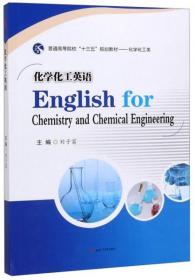
化学化工英语刘子富西南交通大学出版社9787564370367
二手书,此书是一本无赠品和附件,套装不全,购买套装请联系客服
¥ 5 1.0折 ¥ 48 八五品
仅1件
作者刘子富 编
出版社西南交通大学出版社
出版时间2019-08
版次1
装帧平装
货号9787564370367
上书时间2024-12-17
- 在售商品 暂无
- 平均发货时间 7小时
- 好评率 暂无
- 最新上架
商品详情
- 品相描述:八五品
- 商品描述
- 书名:化学化工英语
图书标准信息
- 作者 刘子富 编
- 出版社 西南交通大学出版社
- 出版时间 2019-08
- 版次 1
- ISBN 9787564370367
- 定价 48.00元
- 装帧 平装
- 开本 16开
- 纸张 胶版纸
- 页数 275页
- 字数 576千字
- 【内容简介】
- 《化学化工英语》是根据教育部2017年颁布的《大学英语教学指南》精神要求,旨在进一步贯彻落实高等教育教学改革工作,“满足国家战略需求,为国家改革开放和经济社会发展服务,满足学生专业学习、国际交流、继续深造、工作就业等方面的需要”而为高校大学生提供英语学习方面的积极探索。
- 【目录】
-
Part 1 Chemistry and Chemical Engineering
Unit 1 Chemistry
Unit 2 Chemical Engineering
2.1 Etymology
2.2 History of chemical engineering
2.3 New concepts and innovations
2.4 Safety and hazard developments
2.5 Recent progress
2.6 Concepts
Part 2 Basic Chemistry
Unit 3 Basic Concepts
3.1 Matter
3.2 Atom
3.3 Element
3.4 Compound
3.5 Substance
3.6 Molecule
3.7 Mole
3.8 Ions and salts
3.9 Acidity and basicity
3.10 Phase
3.11 Redox
3.12 Bonding
3.13 Reaction
3.14 Equilibrium
3.15 Energy
Unit 4 Subdisciplines
4.1 Analytical chemistry
4.2 Biochemistry
4.3 Inorganic chemistry
4.4 Materials chemistry
4.5 Neurochemistry
4.6 Nuclear chemistry
4.7 Organic chemistry
4.8 Physical chemistry
4.9 Theoretical chemistry
Unit 5 Pharmaceutical Engineering
5.1 History
5.2 Pharmaceutical industry in the United Kingdom
Unit 6 Pharmacy
6.1 Disciplines
6.2 Pharmacy technicians
6.3 Education requirements
6.4 History
6.5 Practice areas
6.6 The future of pharmacy
6.7 Symbols
Unit 7 Atomic Structure
Unit 8 Chemical Bonding
8.1 Overview of main types of chemical bonds
8.2 History
Unit 9 Chemical Reaction
9.1 Synthesis
9.2 Decomposition
9.3 Single replacement
9.4 Double replacement
9.5 Historical overview
9.6 Basic concepts of chemical reactions
Unit 10 Factors Influencing the Rate of a Chemical Reaction
10.1 Concentration of reactants
10.2 Temperature
10.3 Medium or state of matter
10.4 Presence of catalysts and competitors
10.5 Pressure
10.6 Mixing
10.7 Summary of factors that affect chemical reaction rate
Part 3 Laboratory
Unit 11 Laboratory Apparatus: Chemical Instruments
Unit 12 Recrystallization
12.1 Single-solvent approach
12.2 Two-solvent recrystallization
Unit 13 Acid-Base Titration
Unit 14 Isolation, Purification, and Identification of Caffeine
14.1 Background
14.2 Procedures
Part 4 Academic Reading
Unit 15 A (R)evolution in Chemistry
15.1 Enzymes——the sharpest chemical tools of life
15.2 Human thought has limitations
15.3 Arnold starts to play with evolution
15.4 Mating——for more stable evolution
15.5 New enzymes produce sustainable biofuel
15.6 Smith uses bacteriophages
15.7 Bacteriophages——a link between a protein and its unknown gene
15.8 Antibodies can fish out the right protein
15.9 Antibodies can block disease processes
15.10 Winter puts antibodies on the surface of phages
15.11 The world's first pharmaceutical based on a human antibody
15.12 The start of a new era in chemistry
Unit 16 A Storied Russian Lab is Trying to Push the Periodic Table Past Its Limits——and Uncover Exotic New Elements
Unit 17 The Importance of Synthetic Chemistry in the Pharmaceutical Industry
Unit 18 Extending the Application of Biocatalysis to Meet the Challenges of Drug Development
Part 5 Supplementary Reading
Appendix 1: Introduction about the Undergraduate Programme in Queen's University
Appendix 2: A List of Chemists
Appendix 3: A List of Chemical Engineers
Appendix 4: A List of Vocabulary in Chemistry and Chemical Engineering
Appendix 5: Element Names and Their Pronunciation
Appendix 6: Bilingual List of Common Analytical Instrument and Methods
Appendix 7: Terms Used in General and Inorganic Chemistry
Appendix 8: Terms Used in Organic and Biological Chemistry
Appendix 9: Terms Used in Analytical and Physical Chemistry
References
相关推荐
-

正版现货新书 化学化工英语 9787564370367 刘子富
全新北京
¥ 36.13
-

化学化工英语刘子富西南交通大学出9787564370367
八五品重庆
¥ 20.20
-

化学化工英语 大中专理科交通 刘子富 编
全新北京
¥ 34.35
-

化学化工英语刘子富9787564370367西南交通大学出版社
八五品鹤壁
¥ 2.54
-

化学化工英语刘子富9787564370367西南交通大学出版社
八五品重庆
¥ 11.60
-

化学化工英语 刘子富 西南交通大学出版社9787564370367
八五品成都
¥ 15.59
-

化学化工英语刘子富9787564370367西南交通大学出版社
全新成都
¥ 35.46
-

化学化工英语刘子富 编西南交通大学出版社9787564370367
八五品南昌
¥ 15.29
-

化学化工英语刘子富 编西南交通大学出版社9787564370367
八五品南昌
¥ 15.29
-

二手 化学化工英语 刘子富 西南交通大学出版社 9787564370367
八品安阳
¥ 12.48
— 没有更多了 —












以下为对购买帮助不大的评价